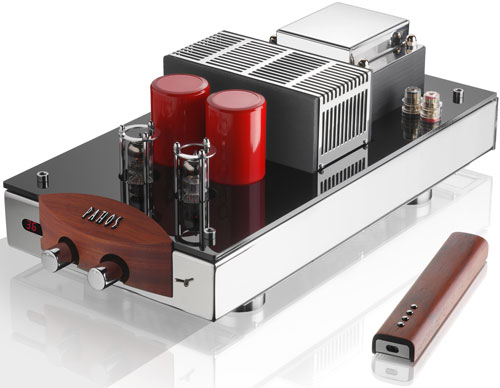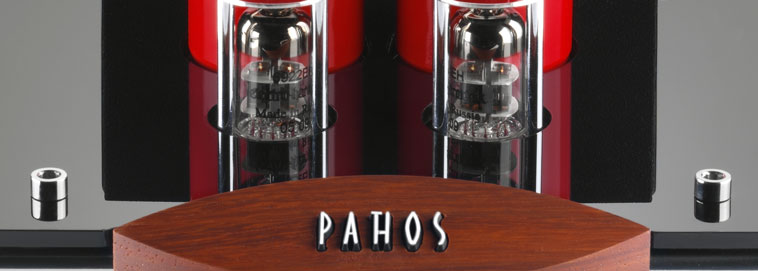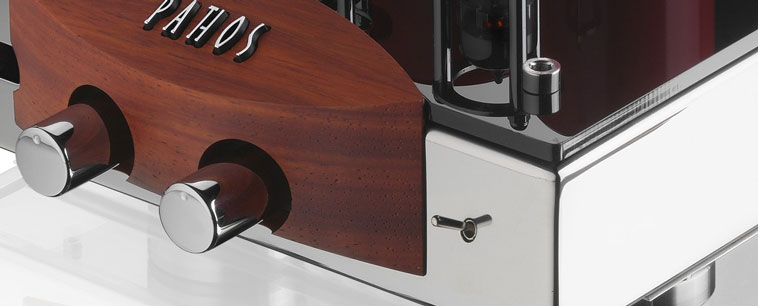Introduction to Classic One MKIII Review: Having been an owner of the bridged Pathos Classic One MkII tube hybrid integrateds, I felt compelled to write of their virtues. The segment of the review dealing with the MkII version of this amp was a labor of love written approximately one year ago. I enjoy the Classic One and want its unique configuration capabilities known to wider circles of audiophiles.
This review has been held for some time prior to publication, as I have now acquired the MKIII version of these amps. In an addendum, I shall detail the differences between the two versions. Please note that small aesthetic and operational differences exist between these two versions; these differences are summarized in the above comments from Pathos. However, these differences may be important, i.e. color options, so if you are a potential buyer I urge you to visit the website, www.pathosacoustics.com, to familiarize yourself with the MKIII.
There’s no mistaking a classy-looking component when one sees it. People who enter my home theater, where twin Pathos Acoustics Classic One MkII tube hybrid integrated amps reside, immediately notice them as being in an entirely different class of component than the usual box and faceplate. Audiophiles (I might venture a guess here, based on familiarity with the topic on electronic forums as well as my own objectives) typically care more about the sound of the equipment than its looks. Not all, but a majority might sacrifice appearance for the superlative sound of a component. Rightly so; if looks are predominant, there are some nifty speaker systems available through The Sharper Image that might satisfy, but have limited value to the audiophile.
.
The Classic One MkII IS a classic in all respects of its design, from the selection of the materials aesthetically, to the sonic performance. Physically, one unit is noticeable, but two are utterly unavoidable! Every person who enters my listening room is immediately drawn to them and ask the same question, “What are those?” In the process, they bypass speakers, at two times the retail value of both Pathos amps, which are every bit as acoustically impressive and contain ingenious technical aspects to their construction and design but are not as visually stunning. The Classic One MkII is an “attention getter.” Frankly, I must admit, it’s great fun to own equipment with a high “Wow” factor! I enjoy telling people, “Those are my Italian tube hybrid integrated amps!”
To obtain technical information on the amp, which doesn’t appear in the owner’s manual, one must look to the website – www.pathosacoustics.com. In keeping with the amp’s looks, it seems Pathos prefers to place the most user-friendly information of the amp’s technical aspects in plain sight of the user. It requires a bit more looking to delve into the details.
In appearance, the Classic One is longer and narrower than most American amps. This may cause an issue if your cabinetry or shelving is narrower to accommodate the 17” standard. Fine, change it. Yup, this is the kind of component that makes it worth changing out furniture! I have never let my shelving dictate what component goes on it. While one’s spouse may dictate what furniture goes into the room, this amp is a perfect argument for buying new furniture!
Rather than being housed inside a conservative shell, the ‘guts’ of the amp sit proudly on display – the transformer, caps, tubes – in all their glory. It is glorious because the interplay of color makes the amp very visually appealing. The transformer stainless steel cover, as well as the casing which houses the other electronics, contrasts with the black acrylic top plate. Standing prominently in front of the transformer are the twin massive red caps. The hint of gold plating on the front knobs (level and selector controls) is caught again at the back in the vertically oriented binding posts which straddle the transformer. Just in front of the caps sit the twin Sovtek 6922 tubes in their attractive chromium cylindrical cages. Tube replacement is made easy by the fact that one can nudge the tubes out or in while leaving the cage intact.
The line level-only inputs include TAPE IN/OUT, TUNER, CD, AUX along with one balanced input. The power plug is detachable; having tried no less than six different power cords, I have settled on the Xindak FP Gold, which seems to mate marvelously with the amp.
The included remote is fashionable, its shell being made of the same wood as the center accent name plate on the amp. Three colors are available – black, Walnut and Rosewood (Note! In the MkIII version only Paduk – Rosewood color – is available). The four vertically oriented buttons control (from top to bottom) VOLUME UP/DOWN, MUTE, and SELECT. To switch sources, one pushes the SELECT button and toggles via the VOLUME UP/DOWN buttons. Functionality is simple and clean, pleasing like the amp itself.
There is a renaissance recently for the integrated amp. For a long while, it seemed that integrateds were for Europeans. Americans have a love affair with big, juicy power amps. Separates were the thing. And while it may be true that one can wring out the last bit of performance in separate pre/amp, units like the Classic One begin to challenge that assumption, especially when bridged.
Which would yield higher performance, separates – a preamp tethered to a power amp – or an exceptionally well designed integrated which eliminates a separate chassis and an interconnect? The use of twin integrateds in mono configuration has made my two channel rig as simple as it gets as far as signal path is concerned. Using only one of the amps IS as simple as it gets. The addition of a second amp hardly complicates things, and the benefit over stereo mode is undeniable.
The Classic One MkII is a revision of the original, which met with mixed reviews. The casual listener enjoyed it, but professionals were unimpressed with its dynamics. Gianni Borinato, the engineer who designed the Classic One was listening, and upon its release, the MkII met with rave reviews.
I found the One in stereo mode to be rich and layered in its presentation. I have always been a “detail” freak, wanting the utmost in resolution, but as I have gotten older (and hopefully wiser) in this hobby, I appreciate increasingly products which deliver such detail with subtle nuance – with grace. That’s what struck me about the Classic One MkII; it wasn’t in my face shoving the song at me, but was simply content to sing beautifully and let me approach the subtleties of the music.
Being a tubed integrated, the sound is definitely more “warm” and would be much to the liking of someone who does not want their ears bothered by shrill treble. I used to own Magnepan 1.6’s, and while they have undeniably impressive soundstage and coherency, their treble was always an issue – which is one reason why owners often switch to tube pre/amps to tame the treble. I found that a tube pre was not enough. I wanted even more gentleness in the top-end, without sacrificing clarity or detail, of course! I sometimes wish I had those 1.6’s back again to listen to them now with the Pathos amps! Maybe the treble would be acceptable.
I found that a single One was competent in driving the sizable Chapman T-77’s. Had this never been produced as an amp that was switchable in a moment from stereo to mono, I likely never would have wanted for more. But, because it can be converted to mono merely by flicking the switch on the underside of the amp, well…who can resist? So began my quest for the bridged mode experience.
I am also aware of the conclusion of some that the bass produced by the One was serviceable but not exceptional. Everyone, it seemed, lauded the mids and highs, but the bass was just ok. I also found the bass serviceable but not compelling, that is, until I heard what the bridged units do! Indeed, the bridged One’s are quite a bit better than the single One being used in stereo.
Over the course of my quest to move from one unit to two, I have become an acquaintance of Gianni, who developed Pathos’ Inpol technology employed on their higher end amps. He is quite proud of the One and its virtues. I knew of no one who had ever tried the amp in bridged mode, and the sound quality I was getting from the One in stereo mode was like a siren song luring me to the edge of the unknown.
Gianni was cautious, suggesting that I may enjoy bridging the amp, but would not commit to assenting that the sound would be revolutionized. Well, it was!
The increase in power was instantly noticeable, not subtle at all. The amp in stereo mode supplies 70Wpc into 8ohms. But in mono mode, this jumps to 170Wpc, and into 4 ohms, according to Gianni, reaches approximately 270Wpc!
This is astounding power for the price, and one would pay dearly to obtain this kind of power in quality separates. Gianni made clear to me that the unit was not intended for driving 4-ohm speakers in bridged mode. The unit would handle 8 ohm speakers easily, but was not officially rated for 4 ohms. The concern was to not overwork the transformer. He warned me that pushing the amps too hard could result in damage.
- (Page 1 of 2)
- Next page →




I have Magnepan 3.6r’s
wondering your thoughts on 2 MK111 powering these bridged?
Keith,
God’s Joy to you,
Simply, briefly, I think it would sound beautiful. Pay special attention to the source, because if perchance you feel there is not enough high end snap, this can be aided by selection of the source – and cables.
I have no doubt that you could achieve a glorious sound with the Pathi; as I indicated in my article, I was able to make engaging systems with nearly any combination of speakers and the Pathos amps in bridged mode.
Blessings,
Douglas Schroeder
As I have interest on Pathos amplifiers for my Sonus Faber Olympica Nova 3s, that I just found this review, thankfully.
I wonder if you have ever compared this bridged classic one mk3s with other Pathos amplifiers, like Inpol2 or TT.
Here I can get ‘2 new classic-one mk3s’ at around $4k, and ‘used Inpol2’ at around $4.5k from a dealer at distance, I’m restricted to visit for audition them.
So I need any of opinion / advice on my decision; “2 x classic one mk3” vs “Inpol2” vs “TT”.
Hi Doug,
There’s no doubt synergy is everything. I tried the Classic Mk III in my system as an experiment to see what my Pure Audio Project Quintet 15 Voxatives would sound like with fast solid state power. I loved everything about the Mk III, and yes the look was fabulous. Alas it just was a bust in my system. I tried rolling various 6922s and just could not get it to work. Sold the Pathos and am back being all tubes.
Best regards and stay safe,
Alan
Wayne, Alan,
Christmas Joy to you,
The PAP Trio15 (can’t speak in regard to the Quintet, as I have not used it) would likely be perceived as somewhat light on the bottom end with the Class One, even in mono mode. It takes a lot of amp to make the twin 15″ open baffles have presence. The use of the PAP-C1 is very helpful in that regard, as the relative output of the horn to the bass can be contoured. In terms of the particular perception of tonality, color, etc. it is going to be quite personal.
I am in the midst of an amplifier review wherein I am using 2,400 wpc (600×4) with the Trio15 Horn1 and also employing the Legacy Audio XTREME XD Subwoofers, with sensational results. The noise floor of this class D amp is stunningly low, so that the PAP now is quite advanced from the review systems. Older recordings are able to be played at higher levels with no perceived degradation from amp noise. The speakers have extremely deep and sonorous sound field now, and the timbral richness without low end bloat is, frankly, better than tube amps I have used. The review of this amp will be forthcoming in 2021.
Blessings,
Douglas Schroeder
Hello Doug. I am updating my speakers to Spendor D7.2 and am considering getting 2 of the Classic Mk III.Your impressions would be very welcome…..Thank you in advance…..Steve
Steve,
God’s Joy,
Have you seen the discussion at Audiogon in regard to the Pathos?
https://forum.audiogon.com/discussions/pathos-classic-one-mkiii-vs-krell-s-300i
No one can tell you which would be preferred. Only a direct comparison can tell. For instance, the Krell may drive the speaker better in terms of macrodynamics, but it may be less desirable tonally. Anyone who simply tells you one or the other is “better” holistically without an actual comparison is guessing.
Blessings,
Douglas Schroeder
Hi Doug, how would mk2 pair in monoblock or is it stereo with Klipsch forte 3 or Cornwall? Thanks
Aitor,
God’s Peace,
My impression of that combo is that it would be very good. The amp in all versions has such a sweet midrange and inoffensive top end that I believe it would pair quite well with these kind of speakers. I had recommended the Classic One for the Tannoy Glenair Speaker, which is in the same sector of speakers, imo.
Blessings,
Douglas Schroeder